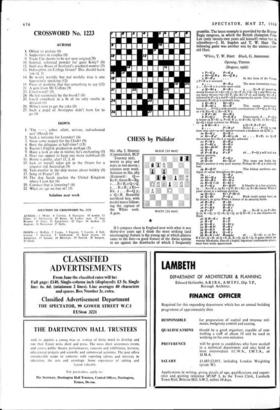CHESS by Philidor
No. 284. J. HARING (Commended, BCF Tourney 107). witrra to play and mate in two moves ; solution next week. Solution to No. 283 (Kennard): Q Kt 8!, threat R-B4. i...BxR;2QxQ. I...KxR;2Kt- K6. B-Q 3; 2 QxB. Beautiful sacrificial key, with model mates follow- ing the capture of the White rook. A gem.
If I compare chess in England now with what it was thirty-five years ago I think the most striking (and encouraging) feature is the young age at which players came to the fore-a good feature of the Swiss system to set against the drawbacks of which I frequently grumble. The latest example is provided by the Bognor Regis congress, in which the British champion Peter Lee (only twenty-two years old himself) twice lost to schoolboys-j. N. Sugden and T. W. Hart The following game was another win by the sixteen-year- old Hart.
'White, T. W. HART Black, G. ABRAHAMS Opening, VIENNA 31 Biz.__KB44 (Bognor, 5966) 2 Kt--Q B 3 .13.....KP-t-QBK :B 3
In this form of the Vienna
3 P-B 4 is unsound. 3 • • • The most interesting move; 3 ... Kt-B 3 ia a little more solid. wrong4 bQ-ecafsteeof 5 Kt-B511. Q x P ch; 6 K-Q and White hat 4 . Q-B 3? would be too many threats-Q x Kt P. also Kt xP ch and finally Kt-Ft. 3 followed by P-Q 3 and P-Q B 3 trapping the queen. Text (which threatens P-Q 4) is probably best. 5 Q-Kt 3Kt-Q 5 13 6 -10 3 Kt x B This re seems premature; better 6 .. P-Q 3 with possible continuations 7 P-Q 3, B-K 3 or 7 K Kr-K 2, Kt-K B 3. 7 R P x Kt Kt-I3_ ..
3
8 P-Q 3 P-IC R 3 Unnecessary. 8 . P-Q 3 better (9 B-Kt 5, P-K R 3; 50 B x Kt, QxB; B; is bet Kt-Q 5, Q-Q leads nowhere for White).
g K Kt-K .
1.-28 3? B9 eQuex,P9x., pch_Ql 3; test loses time and-as will appear-creates a weakness on Q Kt 3.
soKB-R4! B-Kt 5 ch . . . B xB; QxB Q-K 2
Zr t-
threatening Kt-Kt 6 is equally awkward.
12 P-B 3 B-R 4 P-Kt 4 B-B 2 14 Kt-Kt 6! B x Kt
B x B P-R 3
x6 P-K B4 PxP it6 P-Q 3 will lead to a similar position. /7 a x P P-Q 3 18 0-0 Kt-Q 2? This turns out badly but Black's position is very poor anyway. Perhaps B-K 3 is relatively erg B-Q 8! . . . This bishop performs pro- digies of valour throughout the game.
Q-K 3 20 Kt-Q 4 Q-Kt zr Kt-B 5 Kt-K 4
22 B-K 7 ch K-Kt r 23 P-Q 4 Kt-Q 6? A blunder in a lost position; 23 . . . Kt 5; 24 Kt x Q P, Kt x Kt; 25 B x Kt leaves White I pawn ahead. in a winning position. 25 QQ-Qx Kt x P (Kt 7) P-Q 4 Black could resign here; as he doesn't, he gives White a chance of an amusing finish.
26 B-B 5 B x Kt z7 PxB Q-Kt 5 28 P-B 6 R-K r
29P x PI R-R 2 29 R-K 7; 30 P xR■
Black.
Q ch, K x Q; 31 Q x R, Q x Q; 32 Q R-K a is also hopeless for
3o Q R-K r RxR 3r RxR R x P
32 Q-K 2 Q-Ke 3
33 13-I 8! R-R 2
33 54 RQ-_ R KK B8 r --K 36 B-K 7 chl Resigns 36 . . . K-Kt 2; 37 B- B 6 chi, Q x B; 38 Q x R ch, K x Q; 39 R x Q. A game which the veteran Abrahams, himself a highly ingenious combinative player, must have wryly appreciated.


































 Previous page
Previous page